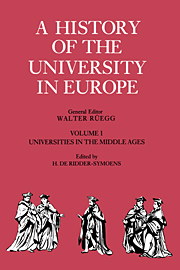Book contents
- Frontmatter
- Contents
- List of maps
- Contributors and editors
- Reader's guide
- Bibliographical abbreviations used in notes
- FOREWORD
- Acknowledgements
- PART I THEMES AND PATTERNS
- PART II STRUCTURES
- PART III STUDENTS
- CHAPTER 6 ADMISSION
- CHAPTER 7 STUDENT EDUCATION, STUDENT LIFE
- CHAPTER 8 CAREERS OF GRADUATES
- CHAPTER 9 MOBILITY
- PART IV LEARNING
- THE FACULTY OF ARTS
- EPILOGUE
- Editors' note on the indexes
- Name index
- Geographical and subject index
CHAPTER 7 - STUDENT EDUCATION, STUDENT LIFE
- Frontmatter
- Contents
- List of maps
- Contributors and editors
- Reader's guide
- Bibliographical abbreviations used in notes
- FOREWORD
- Acknowledgements
- PART I THEMES AND PATTERNS
- PART II STRUCTURES
- PART III STUDENTS
- CHAPTER 6 ADMISSION
- CHAPTER 7 STUDENT EDUCATION, STUDENT LIFE
- CHAPTER 8 CAREERS OF GRADUATES
- CHAPTER 9 MOBILITY
- PART IV LEARNING
- THE FACULTY OF ARTS
- EPILOGUE
- Editors' note on the indexes
- Name index
- Geographical and subject index
Summary
the student: concept and typology
At European universities and in European societies the concepts ‘university’, ‘faculty’, ‘doctor’, ‘master’, ‘student’, and the like have been in use for virtually 800 years. Despite this long usage, however, the realities behind the words have only ostensibly remained the same. In general, modern notions are of little help when it comes to understanding medieval phenomena, and this is particularly true of the social phenomena of universities organized around groups of individuals. Particularly in a chapter devoted to the ‘medieval student’, one must be aware from the outset that concepts can be no more than linguistic shells housing a great variety of different meanings, each dependent on its age. One should therefore approach the matter gingerly, seeking to find neutral terms like ‘scholars’, ‘enrolled members’, or ‘matriculants’ whenever – for reasons of historical fact or linguistic form – it is called for. For the sake of clarity, the term ‘university attender’ will be used in this chapter.
When one surveys the European scene, it is striking that there is not a single university in any country for which one can paint a generalized picture of the medieval student – and this irrespective of century. The mere issues of admission and matriculation serve to show how diffuse the concept is: there was no more or less uniform secondary education, school and university shading into one another, and no hard-and-fast distinction was made between the concepts ‘pupil’ and ‘student’. Both were members of the university and of the school.
- Type
- Chapter
- Information
- A History of the University in Europe , pp. 195 - 243Publisher: Cambridge University PressPrint publication year: 1991
- 11
- Cited by



